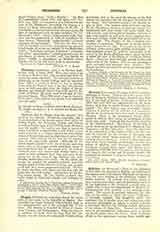

Chibchas (or MUYSCAS).—Next to the Quichuas of Peru and the Aymares in Bolivia, the Chibchas of the eastern and northeastern Highlands of Colombia were the most striking of the sedentary Indians in South America. At present they have ceased to form autonomous tribes and are practically extinct. In the beginning of the sixteenth century they occupied what is now the departments of Boyaca and Cundinamarca with, possibly, a few outlying settlements. The extent of territory indicated was only that of the tribes’ to which the name “Chibchas” is specially applied. The linguistic stock was scattered over a greater area, and indications even authorize philologists to admit as highly probable a connection between the Chibcha dialects and some of the idioms of Costa Rica. Whence the Chibchas came is not established; indications seem to favor the North rather than the South. Their traditions allude to the appearance among them, untold ages ago, of two (or three) powerful men (possibly Shamans) who performed miracles and attempted to teach the Indians a different mode of life. It is not quite clear whether the names “Bochica”, “Nemthequeba”, and “Zuhe” apply to one or several personages. Bochica, however, appears most frequently in Chibcha folklore, and is represented as an old man who came to Cundinamarca from the eastern plains of Venezuela and lived for a fabulous length of time at Sogamoso on the plateau of Bogota.
The creed of the Muysca was the pantheistic fetishism of American aborigines in general. Human sacrifices were not uncommon, but most of the offerings consisted of gold, emeralds, and fruits of the field. Shamans, or Zeques, were numerous, and acted as medicine men, diviners, oracles. The Chibchas lived in villages, the houses being mostly circular, and of wood and thatch. In 1571 the population was approximately given at 150,000 souls. At the head of each tribe stood the usual council, guided by the oracular utterances of the leading Shamans, while an elective war-chief (Uzaque) represented the executive. The clan system prevailed. Agriculture, the gathering of salt, limited hunting, and war—with their neighbors and among themselves—were the chief occupations. In certain cases plurality of wives was licit. Traditional lore leads to the inference that, until the second half of the fifteenth century, the tribe of Tunja was the most powerful one of the Chibchas. About 1470 the Indians of Bogota rose, and when Gonzalo Ximenez de Quesada began the exploration of the mountains in 1536, the Indians led by the Zippa, or war-chief of Muequeta, had to be encountered. By 1538 the Chibchas were virtually conquered, and considerable wealth in gold and emeralds was secured by the Spaniards at Tunja. Subsequent attempts at revolt on the part of the Chibchas proved ineffectual.
AD. F. BANDELIER

